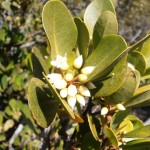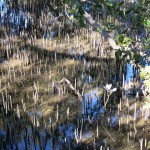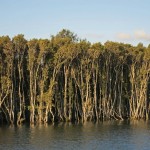Mangroves are surprisingly well adapted to the challenges of living in salty water
It is obvious that mangroves have a very poor public image. Just hearing the word mangrove makes you think of steamy tropical swamps, infested with crocodiles and mosquitoes. There is some truth in this picture, since most of Australia’s 11,500 square kilometres of mangroves are in the north of the country.
However you don’t have to wade through remote tropical swamps to see these medium sized trees. You can find them growing in all mainland states, and even in some of our capital cities. There are more than 40 species of mangroves in Australia, and some of them thrive in the more temperate conditions in the southern half of the continent.
Below the Salt
Mangroves are very unusual plants because they grow in the salty water of inter-tidal regions. In order to survive in such trying conditions, mangroves have made some surprising adaptations to their roots and leaves. These adaptations are easily visible and make mangroves much more interesting than you might expect.
Most plants are unable to tolerate salty conditions, but mangroves manage to thrive in tidal water which has a high salt content. At high tide the salt level is basically the same as in sea water, and at low tide it can be even higher due to evaporation. To live in this difficult environment, mangroves have developed a complex salt filtration process.
They have the remarkable ability to take in salty water, remove the salt, and deposit it through special pores as crystals on the leaf surface. If you look carefully at mangrove leaves on a sunny day, you will see these small salt crystals sparkling in the sunshine.
Putting Down Roots
Mangroves typically grow in a thick forest, with their roots submerged in water and mud. So they have to be able to withstand buffeting by waves and also cope with the low levels of dissolved oxygen that are typically found in the mud. Their roots are well adapted to dealing with these problems. The roots are typically quite extensive, helping to stabilise the tree in the soft mud and also softening the effects of waves by dissipating the wave energy.
The most common and widespread species of mangrove in Australia is the Grey Mangrove (Avicennia marina, also called the White Mangrove), which has found an interesting way to obtain oxygen. The trees of this species have aerial roots called pneumatophores or peg roots, which grow upwards from the underground root system. They project out of the mud and extract oxygen directly from the air. If you look beneath Grey Mangroves, you will see hundreds of these aerial roots. Other species have developed other ways of extracting oxygen from the air.
Somehow Grey Mangroves don’t look like the sort of tree that would have flowers, but in fact they do produce small yellow-white flowers every second year. The flowers are fertilised by insects, and produce seeds. To improve their chances of survival, the seeds develop into seedlings while they are still attached to the parent tree. After about a year, the seedlings drop into the water and float away to take root somewhere else.
Despite their rather poor public image, mangroves are actually very useful plants, providing many useful services to man and to the environment. Their roots trap sediment and toxic materials, helping to prevent erosion of the shoreline and sedimentation of bays. In addition, they provide shelter for many marine species, including fish, crustaceans, shellfish, and birds.
WHERE TO FIND THEM
Most mangroves are located in tidal areas of northern and eastern Australia, especially in Queensland, Northern Territory and Western Australia. The Port Darwin Wetland, beside Charles Darwin National Park, has 36 different species of mangroves. However you will also find them as far south as Wilsons Promontory on the east coast, and Bunbury on the west coast. On the south coast there are mangroves at Tooradin in Victoria and at Barker Inlet in Adelaide. There are even mangroves along the Parramatta River between Sydney and Parramatta, and also at Bundeena beside the Royal National Park.
Mangroves grow along the water’s edge in rivers, estuaries, bays and along the ocean shoreline. Boardwalks have been constructed in some wetlands, so you can see these plants up close without getting your feet wet. Examples include Huskisson in Jervis Bay NSW, Bunbury WA and Tooradin Vic.
For more information about mangroves visit www.mangrovewatch.org.au and click Australia under “Countries”.




